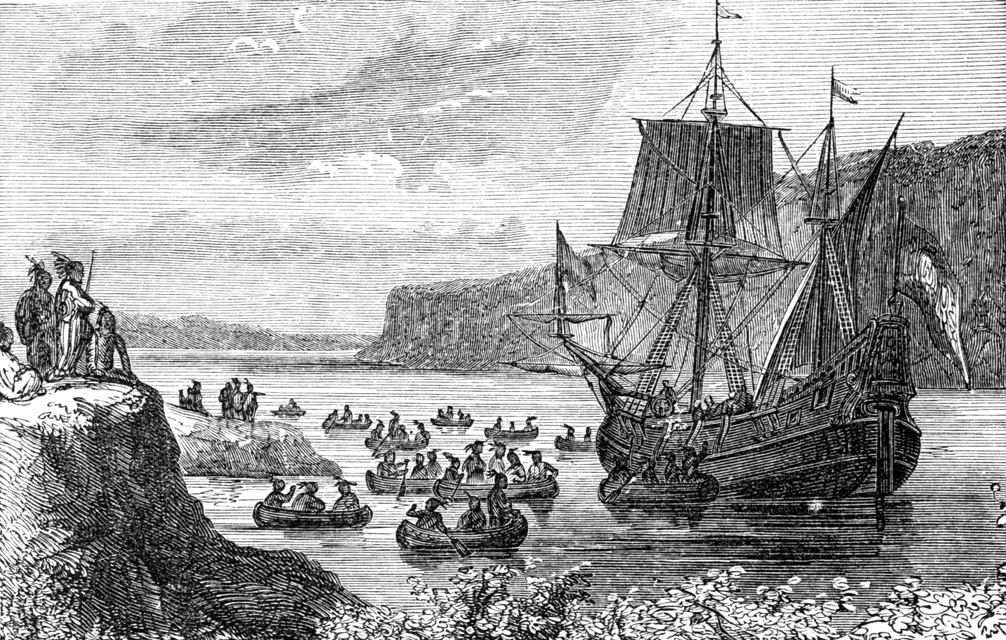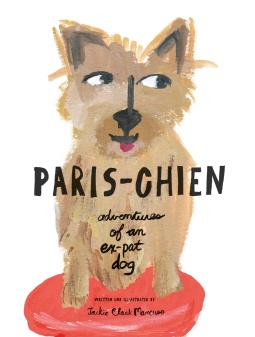 .
.
Paris-Chien: Adventures of an Ex-Pat Dog
written & illustrated by Jackie Clark Mancuso
presenting Hudson
distributed by Small Press United 6/05//2013
978-0-615-54542-4
Age 4 to 8 36 pages
.
“When Hudson, an adventurous Norwich Terrier, moves to Paris, he loves the new sights and smells. But when he tries to make friends, he is surprised to discover that the dogs only speak French. Little Hudson’s desire to make friends and thrive in his new environment is so strong that he learns a new language. Hudson becomes a Parisian, or Paris-Chien, (chien means dog in French).”
Opening
“Hi. My name is Hudson. My mom is a writer and we’ve come to live in Paris for a year.”
Review
Poor Hudson, the real-life dog who owns author/illustrator Mancuso, he now lives in a new culture, with a new language, and one he does not understand or speak. Hudson tries to make friends, but cannot understand anything the French pooches are saying. He wants to go back home. Mom said no, but did have an idea.

I like the beginning of Paris-Chien. Hudson tells us about life as a dog in Paris. People take their beloved pooches everywhere. One guy even takes his dog to work at a shoe store where he greets people. The dog also greets entering customers. How cool is that? Even restaurants accommodate dogs with a human; sometimes with the best table. Hudson also goes to all sorts of places, along with his mom. No matter how he tried, poor Hudson cannot communicate with any other dog.
The story flows nicely from point to point. When Hudson takes lessons in French—Mom’s brilliant idea, taught by a French Poodle (of course)—he begins to pick up the language and other dogs can now understand him. Hudson even found himself a girlfriend! She is a lovely looking French poodle. Did you expect any other breed? The illustrations are nice. Done in gouache, the bright areas are nearly flawless and the lighter areas give the illustrations texture. I love Hudson as he studied—with heavy black glasses perched on his snout.

Children who like dogs will love Paris-Chien, as will adults. Anyone who has experienced the dog culture of Paris will recall memories of time spent there on each page. The animals are adorable, with many breeds represented. There is also a cat, and a squirrel (which is risky given how dogs take off after the rodents). Ex-pat Mancuso’s Parisian dogs are obedient and stay where the illustrator places them in the real Parisian locations. The funny and unexpected twist in the story is good.
Dog parks are finally starting to appear throughout the US, but with Paris dogs having nearly free reign (going to work, and in and out of restaurants. When Hudson cannot find a place to play, and the park he finally finds does not allow dogs—the only one in all of Paris—I loved the twist. Inside the back cover is a list of French words with their English counterpart. Maybe kids who read about Hudson will learn French right long with the smart ex-pat canine. Debut author / illustrator Jackie Clark Mancuso lived in Paris with her dog, Hudson. She based the locations on places she and Hudson frequent. Now that he knows some French, Hudson is a happier dog, willing to somplete their tour of Paris.
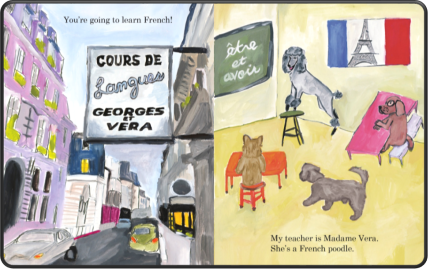
PARIS-CHIEN: ADVENTURES OF AN EX-PAT DOG. Text and illustrations copyright ()C 2012/2013 by Jackie Clark Mancuso. Reproduced by permission of the author, Jackie Clark Mancuso, Los Angeles, CA.
Buy Paris-Chien: Adventures of an Ex-Pat Dog at Amazon —B&N—Book Depository—iTunes—author’s website—at your favorite bookstore.
—B&N—Book Depository—iTunes—author’s website—at your favorite bookstore.
Learn more about Paris-Chien: Adventures of an Ex-Pat Dog HERE.
Meet the author / illustrator, Jackie Clark Mancuso, at her website: http://jackiemancuso.com/
Find more books the Small Press United website: http://www.smallpressunited.com/
French Press.

.
.

Filed under:
5stars,
Children's Books,
Debut Author,
Debut Illustrator,
Library Donated Books,
Picture Book Tagged:
chinldren's book reviews,
dogs,
Hudson,
Jackie Clark Mancuso,
making friends,
Paris,
Paris-Chien: Adventures of an Ex-Pat Dog,
picture book,
Small Press United 







By Roger M. McCoy
Henry Hudson envisioned that he would be the first explorer to find the elusive western passage through North America to the Orient. He persisted in this westward looking vision although his financier, the Dutch East India Company, insisted that he search eastward through the ice-bound sea north of Russia. Hudson had previously tried this northeastern route as well as a northerly route directly over the North Pole. Both had failed due to impassable ice.
On 25 March 1609, Hudson, an Englishman under contract with the Dutch, set sail in the Halve Maen (Half Moon). The Dutch specified that he should not attempt a west route even if the eastern route proved impossible, but Hudson had no interest in another failure. Therefore it is not surprising that he soon found a good reason to end this effort, using the weather as the excuse. As he sailed along the west coast of Norway, the ship encountered severe storms with gale force winds, but examination of the logs also shows much fair weather, raising some doubt that weather actually forced him back. Rather than return to Amsterdam as instructed, Hudson turned west and later anchored in a bay on the coast of Nova Scotia.
On the third of September Hudson sighted an opening to a bay, which appeared to be the mouth of a large river. The next morning they entered what came to be known as New York Bay and dropped anchor. Soon “people of the country” came to the ship carrying trade goods and seemed glad to see the Europeans. They traded green tobacco, deer skins, and maize for knives and beads. He reported that the native people wore skins of foxes and other animals, and were “very civil.” Hudson also noted that the people had copper tobacco pipes, and he inferred that copper naturally existed in the area. Over the next two days other trading sessions took place. Hudson recorded the Indian name for a large island in the river as Manna-Hata.
On the sixth of September five crewmen were determining water depths by boat when they were attacked by natives in two canoes, and one of the crewmen, John Colman, was killed by an arrow in the neck. When Indians came again with their trade goods, the ship’s crew captured two of them briefly, but set one free while the other jumped overboard. No more trading took place under these tense conditions.
Hudson weighed anchor on 13 September 1609 and began his exploration up the great river that still bears his name. He hoped this river might be a connection to the Orient. As the Halve Maen sailed up the river, Hudson wrote in his log, “It is as pleasant a land as one need tread upon; very abundant in all kinds of timber suitable for ship building and for making large casks or vats.” Sixty miles up the river they reported seeing many salmon. “Our boat went out and caught a great many very good fish.” Indians came to the ship and traded corn, pumpkins, and tobacco for what Hudson considered mere trifles, not knowing that the Indians saw these “trifles” as valuable for commerce among themselves.
On the twenty-second of September they found the river too shallow to continue farther upstream, and in the vicinity of present day Albany they turned the ship for a return to the sea. The ship’s log ends during the return crossing with a puzzling gap from the fifth of October to the seventh of November, when the Halve Maen docked in Dartmouth, England. There Hudson was detained by the Crown to prevent him from sailing again for the Dutch. After months of delay the Dutch portion of the crew continued to Amsterdam.
Henry Hudson failed in his quest for a passage through North America, as did many others. This third voyage, however, succeeded by claiming much of present day New York and parts of surrounding states for the Dutch, who began to settle the areas around New York Bay. The Dutch managed to hold their claim until 1674 when the land was ceded to the British.
Why did Hudson stop in England rather than Holland? There is no clear answer; perhaps he was avoiding repercussions for blatantly disregarding instructions, or perhaps the English component of the crew forced him to stop in England. The gap in the log might have shed light on this question. There are several known instances of dissent and mutiny among Hudson’s crews over his four voyages, the last one leading to his abandonment and disappearance with eight others on the shore of Hudson Bay in June 1611. Hudson’s greatest weakness was a leadership style that provoked his crews to mutiny, and in the end this weakness defeated his ambition for exploration.
Roger M. McCoy is Professor Emeritus of Geography at the University of Utah. His books include On the Edge: Mapping North America’s Coast and Ending in Ice: The Revolutionary Idea and Tragic Expedition of Alfred Wegener.
Subscribe to the OUPblog via email or RSS.
Subscribe to only American history articles on the OUPblog via email or RSS.
The post What about Henry Hudson? appeared first on OUPblog.

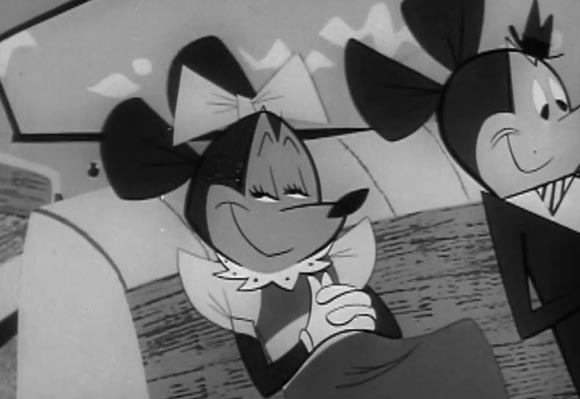
For a short period of time during the mid-1950s, the Disney company allowed corporations to use its characters to sell products. There’s some interesting history behind this, and if you’re interested in learning more, I’d recommend this two-part series by historian Jim Korkis (part one, part two).
Among the companies that took advantage of this opportunity was American Motors, maker of Nash and Hudson cars. (Interesting sidenote: the company’s president at the time was Mitt Romney’s father, George W. Romney.) Yesterday, YouTube user ZarakPhoto uploaded a fine collection of the American Motors spots featuring Jiminy Cricket and Mickey Mouse. I’ve seen other prints of these spots, but these are easily the crispest versions I’ve encountered and worth a look even if you’ve seen them before:
Here’s an upload from another YouTuber with a lower-quality version of one of the other spots featuring Song of the South characters:
The commercials were designed by Tom Oreb, who in my humble opinion, was the most versatile and skilled designer during the Golden Age of Hollywood animation. Oreb’s assistant art director and layout artist on these spots was Vic Haboush, who was a dear friend and mentor to me.
This is Oreb’s model sheet of the “commercial” Mickey Mouse, which Vic and I discovered in his personal collection many years ago. Click for a larger version:
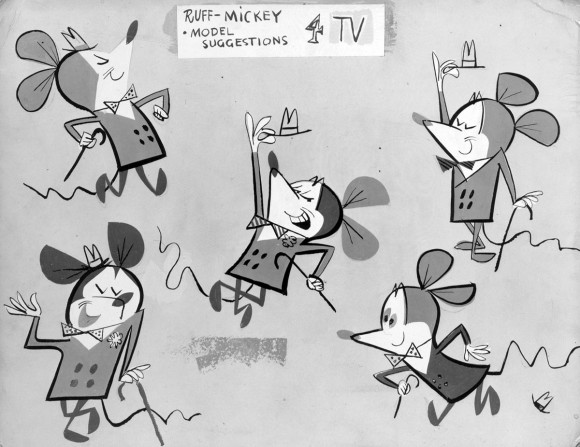

Today the world turned its eyes to Washington, DC where the United States inaugurated its 44th President, Barack Hussein Obama. And while most of our executives have been sworn in here on the banks of the Potomac, our first head of state actually took office a stone’s throw from another river: the Hudson. On April 30, 1789, George Washington took his oath of office in front of a crowd assembled on Wall Street in lower Manhattan. After a long trip from his home in Virginia, he was rowed to New York and walked to Federal Hall, the site of his inauguration and the birthplace of American government. At the time, the city’s inhabitants numbered roughly 30,000, and its homes and businesses did not extend much further than the modern location of Canal Street. Just ten years later, the population of the country’s first capital had swelled to more than 60,000 residents.

Ben Keene is the editor of
Oxford Atlas of the World. Check out some of his
previous places of the week.
 .
.


—B&N—Book Depository—iTunes—author’s website—at your favorite bookstore.





